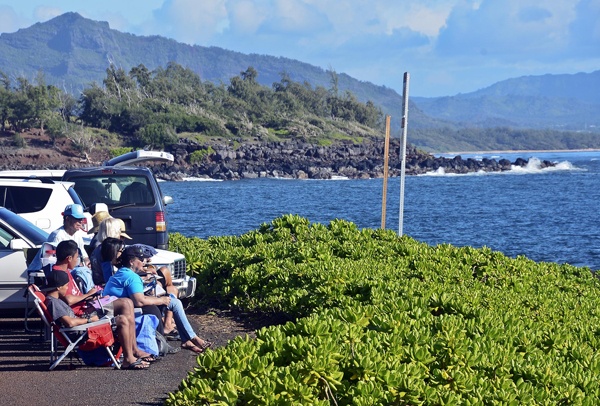LIHU‘E — No one saw Moby Dick Saturday, but dozens of Kaua‘i volunteers counting humpback whales saw the highest average of whales two months in a row — four whales every 15 minutes — since a count was first taken
LIHU‘E — No one saw Moby Dick Saturday, but dozens of Kaua‘i volunteers counting humpback whales saw the highest average of whales two months in a row — four whales every 15 minutes — since a count was first taken in 2005.
More than 120 Kaua‘i volunteers joined the 600 volunteers from across the state in gathering data from the shores of Kaua‘i, O‘ahu and the Big Island during the annual Hawaiian Islands Humpback Whale National Marine Sanctuary Ocean Count, Saturday.
The count is a yearly shore-based census which provides snapshot data on humpback whales, a news release states. Saturday’s count marks the final count for 2013, following counts in Jan. 26 and Feb. 23.
Participants tally humpback whale sightings and document the animals’ surface behavior during the survey with reports being recorded every 15 minutes.
Christine Brammer, the communications coordinator for the sanctuary, said volunteers collected data from 60 sites statewide, including 15 on Kaua‘i.
A total of 194 whales were seen between the 8:30 to 8:45 a.m. time period, the most of any time period throughout today’s count. A total of 58 sites provided information.
The day started with excellent viewing conditions at most locations, but rain eventually canceled a few sites, Brammer said.
“Luckily, there was a break in the weather and the early hours of the count were conducted under generally clear skies and flat ocean conditions which made for excellent whale viewing conditions,” said Jean Souza, the Kaua‘i program’s coordinator. “By 11 a.m., however, four sites, including Lumaha‘i, Princeville, Kilauea Lighthouse and Crater Hill, were affected by heavy rain. Four sites closed down early due to the weather, including Lumaha‘i, Princeville, Kilauea Lighthouse and the Kapa‘a Overlook.”
During the 8 a.m. to 12:15 p.m. count, Kaua‘i averaged four sightings per 15-minute interval, the most observed in the state. O‘ahu and the Big Island averaged three sightings in the 15-minute interval.
The Kaua‘i average equals the February count average. It is an increase for the March, 2012 count where only one whale was sighted during the 15-minute interval. The average is also the highest since records started being kept in 2005.
The Pacific Missile Range Facility at Mana was the most productive site with 10 whales being spotted during the 15-minute interval. Kilauea Lighthouse, before being shut down due to weather, reported eight sightings followed by Ninini Point with five sightings in the 15-minute interval.
Princeville, Crater Hill, Maha‘ulepu-Makawehi, Makahuena Point, Kaiwa Point and Port Allen cemetery all reported four sightings in the 15-minute interval.
In addition to collecting data on humpback whales, other marine life, including dolphins, turtles, and seabirds are also counted. In areas where there is high visitor traffic, whale education is also provided, 261 people being the beneficiary of whale education, Saturday.
“We are very appreciative of the managers and landowners who have continued to allow the sanctuary ocean count to be conducted from their properties,” Souza said. “In addition, the volunteers, who come from near and far, with nearly all having gone through a minimum of two hours of special training, have been fabulously supportive and conscientious. Everyone’s efforts go a long way in fostering a whale watching culture.”
The sanctuary is administered by a partnership of National Oceanic and Atmospheric Administration’s Office of National Sanctuaries and the state Department of Land and Natural Resources. It protects humpback whales and their habitat in Hawaiian waters, where they migrate each winter to mate, calve, and nurse their young.
Visit www.sanctuaryoceancount.org for information on becoming a sanctuary ocean count volunteer for 2014. Visit www.hawaiihumpbackwhale.noaa.gov for more information.


